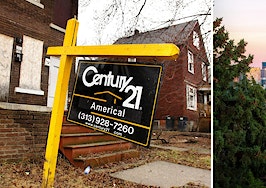Renters are stuck between a rock and a hard place. Despite rent growth slowing to under three percent over the past six months, median rents have soared to $4,000 in coastal hotspots like New York, Boston, Los Angeles and San Francisco while the other option, homeownership, isn’t any cheaper.
Zillow’s latest consumer report, however, shows that, in spite of high home prices, renters are carefully weighing the benefits of homeownership versus renting. In the past year, 46 percent of renters who moved considered buying a home after a rent hike of at least $125.
Here’s how three real estate agents in three distinct markets — New York City, Chicago and Fargo — are helping renters make their dreams come true.
Alleviate personal finance concerns with a pre-qualification and pre-approval

Bridget Harvey
New York City-based Douglas Elliman agent Bridget Harvey says one of the biggest concern renters have about homeownership is their ability to qualify for and afford a monthly mortgage payment. To help quell any fears, Harvey has renters who attend her first-time homebuyer class complete pre-qualification and pre-approval forms.
The pre-qualification process allows renters to plug in basic information such as their annual income, mortgage term and interest, credit score, their monthly recurring debt payments for things such as credit card, student loan and car loan debt and monthly estimated property tax, insurance and homeowners association fees.
After providing those estimates, renters are able to find out the maximum loan amount they’re qualified for.
From there, renters are also able to start the pre-approval process, which is similar to the pre-qualification process except renters must verify their financial information with tax returns, W-2s, etc., with the help of an onsite mortgage lender that assists Harvey with her classes.
“The preapproval process is free and non-binding,” she said. “And most renters are pleasantly surprised at what they can actually afford. Some of them even begin looking at homes that weekend.”
Meanwhile, other renters realize that they have more work to do whether it’s in terms of increasing their income, improving their credit score, paying down debt or bolstering their down payment savings. Those renters often come back the next year ready to buy, Harvey says.
Address affordability concerns with a comparative market analysis

Danielle Moy
Chicago-based Coldwell Banker agent Danielle Moy says she provides renters with a comparative market analysis that looks at rent and for-sale listings. The analysis focuses on rental and for-sale listings that are similar in terms of square footage, age, amenities, upgrades, condition, and location.
Moy says the rental market in Chicago is tight due to low inventory, so the CMA often reveals that renters can save anywhere from $400 to 500 dollars a month by buying.
“I try to explain to them that they’re better off buying because if you rent something and you’re paying $1,800 a month over a 12 month period, now that money is gone,” she said. “Eighteen-hundred is the average cost of a rental in our area, and $1,800 times 12 is $21,600 — that’s more than some of the down payments required for a house [in the Chicagoland area].”
From there, she’ll list the other costs renters need to be aware of, such as homeowners insurance, annual taxes, and closing costs. Moy says renters in Chicago are particularly concerned about property taxes, which have been known to dramatically fluctuate from year to year.
Moy helps renters battle fears about these costs by revealing ways they can save on insurance, appeal property tax assessments, and negotiate closing costs.
“It’s a good time to buy,” she said. “I just have to show them.”
Arrange multiple loan and down payment options

Jenny Buhr
Fargo-based real estate agent Jenny Buhr focuses on helping renters understand the number of mortgage loan and down payment assistance options that make homeownership more accessible.
In her first-time homebuyer classes, Buhr educates renters about the difference between conventional loans and FHA loans, both of which provide low down payment options.
For example, creditworthy renters can qualify for conventional home loans with low down payments such as Fannie Mae’s non-FHA backed HomeReady mortgage and Conventional 97. With these loans, buyers can put down as little as three percent but must pay a monthly mortgage insurance premium (MIP) until 20 percent of the loan is paid off.
For renters who can’t qualify for conventional loans, they may be able to qualify for a Federal Housing Administration (FHA) loan that only requires 3.5 percent down and a monthly MIP.
Buhr also educates buyers about down payment assistance programs offered by individual cities, such as Fargo, and she’s even teamed with the North Dakota Housing and Finance Association to provide $7,500 in down payment assistance to renters who attend her first-time homebuyer classes and are qualified for a loan.
“You can’t just decide one day that I’m going to become a homeowner,” she said. “There’s a bit of preparing that you have to do and I’m here to help them do that.”
Always keep the renter first
All three agents say there are situations where homebuying just isn’t the best option, whether it’s because of the renter’s financial situation or lifestyle needs. In that case, it’s always best to be honest with the renter and make yourself available for future assistance.
“We give them as much guidance as possible, but I’d never push someone into buying a home if it isn’t good for them,” said Harvey.
Although Buhr never solicits renters to hire her, she does give them the option to sign up for emails that provide helpful homebuying information so they’ll be prepared for when they do decide to become homeowners. She also suggests that agents become a certified first-time homebuyer class instructor — not only do you get to grow your sphere of influence, it helps you to better serve clients who are ready now.
“The more educated you are, the better you can educate your clients,” she said.












